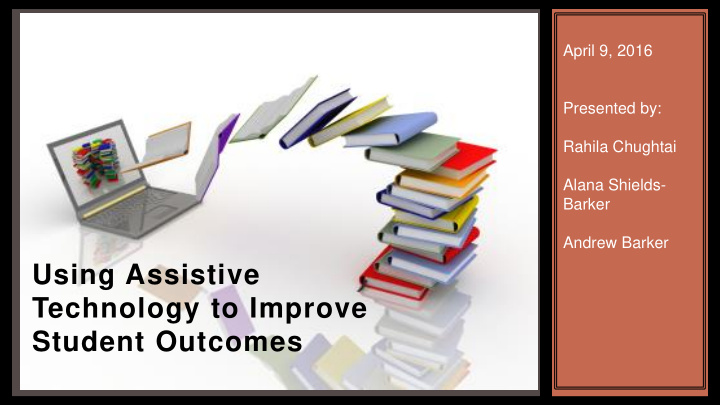



April 9, 2016 Presented by: Rahila Chughtai Alana Shields- Barker Andrew Barker Using Assistive Technology to Improve Student Outcomes
Assistive Technology Assistive Technology is any technology that helps a student with special learning needs maintain or improve his/her academic performance. Its applications and adaptations can help open doors to previously inaccessible learning opportunities for many children with special needs (Judge, 2001).
Barriers to Learning Receptive / Expressive language ➢ Difficulty understanding & following group direction ➢ Difficulty understanding expectations ➢ Difficulty communicating what they know or understand ➢ Visual learners Sensory Processing ➢ Inability to focus due to over/under stimulation of senses ➢ Difficulty with handwriting and other motor activities ➢ Easily overwhelmed due to sensory overload, possibly leading to meltdowns
Barriers to Learning Executive Function ➢ Difficulty in task initiation, sequencing and task completion ➢ Time management, self regulation and maintaining focus can be challenging ➢ Lack of response inhibition ➢ Difficulty in working memory and organization Social skills and the hidden curriculum ➢ Reading non-verbal messages from teachers and peers ➢ Difficulty understanding unwritten rules and expectations ➢ Difficulty with flexibility: rule-bound, black and white thinkers
Why use technology? Reprinted with permission from Karina Barley, M.Ed. from her presentation “Bloom’s Digital Taxonomy” www.digitallearningtree2.com/
“Using the iPad (technology) purposefully with educational outcomes in mind elevates this technology to an educational tool that can be integrated into the curriculum.” Reprinted with permission from Karina Barley, M.Ed. from her presentation “Bloom’s Digital Taxonomy” www.digitallearningtree2.com/
Student Profiles: Sam • Sam an 11yr old with GDD and ASD • Struggles with executive functioning skills and receptive/expressive communication • Gross motor and fine motor delays • Has access to computer and iPad at home and school
Student Profiles: Sam Sam’s Communication Book
Student Profiles: Sam Understanding money was a challenge …
Student Profiles: Sam ...but with the right tools, it transformed to a real life skill!
Student Profiles: Sam How is technology helping Sam? • Now in charge of his communication between home & school • Learning new concepts and achieving at a level which was previously considered to be beyond his ability • Building confidence through independence • Participating in the school and community at levels previously considered beyond his ability
Student Profiles: Andrew • Diagnosed at age 4: ASD (Asperger’s Syndrome), Sensory Integration Disorder • Additional Diagnosis at age 12: ADD, Learning Disability • Currently 19yrs old • Attending Seneca College in Dual Credit Program . • Accepted into CYW program at Seneca for the fall.
Student Profiles: Andrew Grade 5 Math: Introduction of language-based problems created more Learning difficulties Handwriting lengthy Fine motor skills + paragraphs for test language comprehension questions challenge = OVERLOAD Language comprehension Teasing the math + teasing out the actual problem out of the math problem = jumble of words OVERLOAD
Student Profiles: Andrew Executive Function Challenges Tech Support Solutions Google Calendar Difficulty tracking helps him track assignments & due important dates dates Teacher uses Moodle program for the whole class Scanning, completing & printing worksheets was Scans, completes & time consuming and submits worksheets teacher/EA dependent on iPad
Student Profiles: Andrew How did Technology help Andrew? • Task planning is easier to break down • Eliminated the stress and sensory overload • Increased Autonomy and Independence • Now has CHOICE - Completes 1500 word essays using both computer and handwriting • Became Honours Student in Grades 11 and 12 consistently
Student Profiles: Nick • Nick, 10yr old boy with Autism • Non-verbal and sensory seeker • Not being able to communicate led to “ behaviours ” • Uses Proloquo2Go on iPad at home and school
Student Profiles: Nick Expresses his wants and needs “I want pancakes”
Student Profiles: Nick Socializes with peers “play with me!”
Student Profiles: Nick Expresses his feelings and emotions “I feel sick” “I am hurt”
Student Profiles: Nick How is technology helping Nick? ● Family, therapists and teachers now have an understanding of his abilities, and are able to teach and challenge him at his level ● Nick is not getting frustrated and has much less “ behaviours ” ● As he is able to communicate Nick can now focus on learning at school and socializing with his peers
Technological Supports: Computers Word prediction & writing software helps students struggling with fine motor and writing Text to Speech & Speech to Text software makes curriculum accessible for students with reading/writing challenges Graphic Organizers help visual thinkers create mind maps Alternative Keyboards help students overcome visual, fine motor and reading/writing challenges
Technological Supports: Tablets Notability Scans handouts and converts to PDFs, which can be completed by stylus or typing Book Creator Create stories, social stories, learning new concepts Reminder Use for daily, weekly reminders, homework reminders, checklists, to do lists iWordQ Reading & writing app, offers word prediction, speech feedback, document sharing, proof reading and reading to learn assistance
Technological Supports: Tablets Read2Go Accessible ebook reader for Bookshare titles Gives access to largest online library for people with disabilities MathBoard Configurable math app, for grades K to 7 Teaches addition, subtraction, multiplication, division Pictello Create social stories, visual schedules, write personal narrative using pictures, create ebooks Popplet Capture and organize ideas, make visuals for clarity, create mind maps
Technology... ...must be an integral part of daily learning for students with special needs, always accessible and seamlessly integrated ...does not replace social interaction and good teaching practices
Reprinted with permission from Karina Barley, M.Ed. from her presentation “Bloom’s Digital Taxonomy” www.digitallearningtree2.com/
“For people without disabilities, technology makes things easier. For people with disabilities, technology makes things possible.” Mary Pat Radabaugh Director IBM National Support Center for Persons with Disabilities, 1991
With Special Thanks to.... Micah and Mandy Klein Robyn and Nicholas Senior Andrew Barker Karina Barley, M.Ed. Jodi and Kyle Echakowitz Anne Mason Sherry Caldwell Daniele Fiorindi
Recommend
More recommend